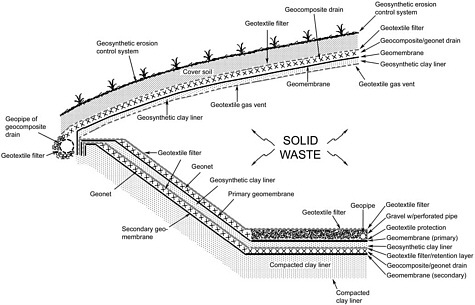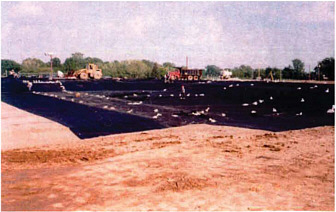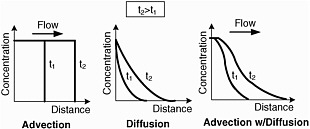1
Introduction
“Municipal” waste dumps have existed in the western world since at least 500 B.C.,1 but it was not until landfills began to be built according to established guidelines that the concept of engineered containment systems was born. By that definition, the first engineered barriers were built in the 1960s, after the U.S. Public Health Service and the American Society of Civil Engineers published guides recommending that waste be compacted and covered with a new layer of soil each day to guard against rodents and odors.2
Waste disposal systems have since become increasingly sophisticated, driven by advances in research and engineering practice, the generation of increasing amounts of hazardous and toxic wastes, and new requirements in state and federal regulations. Modern waste disposal systems and barriers to isolate subsurface contaminants are engineered to provide safe long-term containment of municipal solid waste, other nonhazardous solid and liquid waste (e.g., industrial waste), hazardous and toxic wastes, and low-level radioactive waste. Engineered barriers are used to contain this waste, to prevent the movement of contaminants offsite, to minimize infiltration of surface and groundwater into the waste, and/or to render waste less harmful to people and ecosystems for tens to hundreds or thousands of years, depending on the type of waste and local circumstances. Design and initial performance criteria and monitoring requirements for these containment systems are governed by federal and state environmental regulations.
There are approximately 4,000 landfills in the United States (Bonaparte et al., 2002) and about 7,800 contaminated sites awaiting corrective actions and cleanup.3 Corrective actions have already been completed for approximately 328 sites under the Resource Conservation and Recovery Act (RCRA; personal communication from Tom Rinehart, Chief, RCRA Corrective Action Branch, Environmental Protection Agency [EPA], on September 26, 2006) and many more sites under state jurisdiction or owner or operator control. An assessment of the performance of permitted modern landfills and contaminated-site corrective actions is timely now that some of these engineered barrier systems are approaching the end of their postclosure monitoring periods (commonly 30 years).
The Committee to Assess the Performance of Engineered Barriers was established to provide a technical assessment of the available information on engineered barrier performance over time. The charge to the committee is given in Box 1.1.
The two primary questions addressed in this study are: How well are engineered barrier systems working? How
|
BOX 1.1 Committee Charge In order to develop an improved framework for assessing the effectiveness of surface and subsurface engineered barriers over the long term, an ad hoc committee will complete the following tasks:
|
|
1 |
The first documented waste dump was built in Athens. See <http://www.epa.gov/epaoswer/non-hw/muncpl/timeline_alt.htm>. |
|
2 |
<http://www.epa.gov/epaoswer/non-hw/muncpl/timeline_alt.htm>. |
|
3 |
These include sites regulated under RCRA; the Comprehensive Environmental Restoration, Compensation, and Liability Act; the Uranium Mill Tailings Radiation Control Act; and the Low-Level Waste Policy Act. See <http://web.em.doe.gov/bemr96/umtra.html> and Environmental Protection Agency Superfund, Radiation, and Wastes pages at <http://www.epa.gov>. |
long are they likely to work effectively? The answers to these questions were derived from analysis of available data and case history information, input from federal agency managers and outside experts, information provided by waste containment facility operators and technical personnel, and the research and practical experience of members of the committee.
This report focuses on engineered barriers that were designed to contain municipal solid waste, other nonhazardous solid and liquid waste, hazardous and toxic wastes, and low-level radioactive wastes. Barriers constructed for both waste landfills and corrective action containment and cleanup of contaminated sites were considered. Barrier systems that were intended to treat rather than isolate waste (e.g., reactive barriers that transform contaminants into nonhazardous substances) were not considered.
Many barrier systems are intended to function for tens to thousands of years. Because most regulated sites have been in operation less than 30 years, it is not possible to make unequivocal conclusions about the actual long-term performance of these systems. Consequently, the focus of this report is on performance over periods of several tens of years—the operating, maintenance, and monitoring period for many waste collection systems (Box 1.2)—and on information that provides useful insights about future behavior. Partly because of the very long times (on the order of 1 million years) required to isolate high-level radioactive waste, and partly because no examples exist in the United
States, engineered barriers for high-level radioactive waste were not evaluated.
1.1
WHAT ARE ENGINEERED BARRIERS?
Engineered barrier systems for surface and subsurface waste containment comprise components designed to contain, control, and retard the migration of contaminants toward and within the subsurface and to prevent surface water from infiltrating into the waste or contaminated ground. These component systems may include a low-permeability bottom, side walls, and a cover, as shown schematically in Figure 1.1. Barrier materials typically include natural or modified soil; cementitious, bituminous, and synthetic materials; aggregates; and reactive media, usually arranged in layers. Figure 1.2 shows a geomembrane cover system constructed to prevent ingress of surface water into contaminated ground. The component systems and the materials from which they are constructed are the product of extensive materials research, theoretical analysis, laboratory testing, field measurements, and construction considerations.
Engineered barrier systems can be used to control migration of both liquids and gases (Box 1.2). Most engineered barriers are designed to control advective contaminant transport (i.e., movement of dissolved and suspended materials within flowing fluids) and to intercept and contain the flow of contaminants. In addition, barriers are designed to promote contaminant retention by mechanisms such as sorption, and they may also hinder diffusive contaminant transport. The potential for direct contact by humans or other organisms may also influence the design and effectiveness of engineered barriers.
Engineered barrier system components include bottom barriers, covers, and lateral barriers or walls. These components may comprise a single element with a single mechanism to control contaminants, such as a low-permeability vertical barrier wall to control advective transport. Usually, however, liners and covers contain several different component layers, each with a specific role. An example is a bottom barrier composite liner system that employs a high-permeability drainage layer to extract contaminated liquids (leachate) and/or gas overlying a low-permeability barrier to resist advective and diffusive transport of liquids and gas.
No engineered barrier system can be relied on to completely halt the transport of contaminants, but the rate of release of contaminants to the environment can be minimized. Consequently, most engineered barrier systems are monitored for effectiveness and proper functioning.
Waste repositories and containment systems are a unique and difficult class of structures because (1) small component

FIGURE 1.1 Schematic drawing of a municipal solid waste landfill. SOURCE: Bonaparte et al. (2002).

FIGURE 1.2 Geomembrane cover placed over contaminated ground as part of a RCRA Corrective Action at Love Canal in New York state in 1989. SOURCE: Scott Parkhill, Miller Springs Remediation Management, Inc.
failures or areas of damage can compromise the integrity of the entire system and (2) the operational lives are so long (up to thousands of years). Although an extensive body of literature exists on the performance of some barrier components, especially liners and covers, information on the performance of other components, especially vertical barriers, is sparse.
1.2
WHAT IS PERFORMANCE?
The performance of barrier systems can be defined in relation to governmental regulations (e.g., prescriptive requirements, performance standards, environmental impacts). A common definition of good performance is whether the components and systems function as designed in terms of specified measured or observed parameters. The rate of release of contaminants from a barrier system, if known, and/or the detection of excessive contaminant concentrations beyond barrier boundaries (i.e., at a specified point of compliance) are the most commonly used measures of performance. Performance can be defined in terms of the magnitude of the flux of contaminants, liquids, or gases at a given time; the cumulative or average magnitude of the flux over a period of time; or the length of time to reach a given magnitude of flux. Prescriptive criteria for the composition of the barrier itself and performance criteria for system components can also be used to define barrier performance. Examples of component prescriptive criteria include the following:
-
the hydraulic conductivity of a clay liner is less than a specified maximum allowable value and the thickness of the liner is greater than a specified minimum required value;
-
the hydraulic conductivity and thickness (or transmissivity) of a drainage layer are greater than specified minimum allowable values; and
-
the thickness of a geomembrane or a vegetated erosion control layer is greater than a specified minimum required value.
Examples of system performance criteria include the following:
-
the head in a drainage layer is less than a specified maximum value or
-
the flow rate into a leak detection system is less than a specified maximum value (the action leakage rate).
Other definitions of engineered barrier performance consider both the barrier system and the interactions between the barrier system and the environment (see Appendix A). An example measure of this broader definition is that water, air, and soil quality pose an acceptable risk to human health and the environment, where risk is expressed as an incremental lifetime cancer risk for humans, a hazard quotient for humans or ecological systems, a toxicity unit for ecological systems, or a line of evidence for ecological systems. Such measures require subjective analysis beyond the scope of this report; consequently, this report focuses on the performance of the barrier system itself.
1.3
ORGANIZATION OF THE REPORT
This report provides a framework for assessing the effectiveness of engineered barrier systems and their surface
and subsurface components over periods extending beyond several tens of years, although this necessarily requires extrapolation of data and observations obtained over shorter time periods. The intended audience includes government agencies responsible for developing regulations and guidelines to ensure compliance with regulations to protect human health and the environment, scientists and engineers interested in identifying areas of uncertainty and carrying out additional study, individuals concerned with the long-term safe containment and remediation of contaminated sites, and managers of engineered disposal facilities.
The report is organized into six chapters. Chapter 2 provides an overview of engineered barrier systems, including waste types, barrier materials and their roles as components of waste containment systems, and systems for isolating and containing different types of waste. Statutory requirements and methods for monitoring performance are summarized in Chapter 3. Details on how key parameters (e.g., hydraulic head) are measured and used appear in Appendix B, and construction quality assurance techniques for monitoring barrier element integrity appear in Appendix C. Chapter 4 summarizes observations and predictions of the performance of barrier system components, based on field data, laboratory studies, and modeling. Additional information on predicting impacts on human health and the environment is given in Appendix A. The overall field performance of engineered barrier systems, including case histories, is presented and evaluated for completeness and reliability in Chapter 5. Finally, Chapter 6 identifies information gaps and research needs and presents recommendations for both assessing and enhancing the long-term performance of engineered barrier systems.







